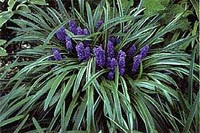Resource Library
Plant of the Week: Lilyturf (Liriope)
The University of Arkansas System Division of Agriculture does not promote, support or recommend plants featured in "Plant of the Week." Please consult your local Extension office for plants suitable for your region.
Plant of the Week
Lilyturf, Liriope
Latin: Liriope muscari 'Variegata'

Landscape styles, while maybe not quite as fickle as Paris fashion trends, continually evolve as dictated by the whims, wants and needs of the gardening public.
Here in the South, the leading purveyor of landscape style has long been Southern Living. The magazine has both chronicled the change over time and significantly influenced the magnitude of the change.
This year at the Arkansas Flower and Garden Show, Steve Bender, a garden editor with the magazine, will travel to Little Rock from Birmingham, Ala., and discuss his perspective on landscaping, southern style.
Certainly one of the plants that has helped define the southern landscape style is Liriope, the quintessential edging plant. This mostly evergreen member of the lily family grows in dense clumps with only long, grasslike leaves seen above ground. Plants ultimately reach 16 inches in height and form clumps 8-10 inches across at the base.
The variegated form has a creamy yellow margin that runs the length of the leaf. It makes a nice color contrast for other evergreens or to brighten dark corners of the landscape.
Lilyturf flowers in August when most of us are tethered to the lifeline of our air conditioners and miss its elegant display. Flowers are light blue, individually small but borne up a slender scape that is held above the foliage. The species epitaph, "muscari," is descriptive of what the individual flowers look like – tiny grape hyacinth flowers.
Liriope makes an effective display when the flowers appear and undeniably makes Liriope one of the plants with multiple seasons of interest. After flowering, pea-size black berries form that persist well into winter.
Like many of our favorite southern landscape plants, Liriope hails from southeast Asia. There are two species common in cultivation. Liriope muscari is the polite, well-mannered species that stays in an orderly clump where its planted. L. spicata is a bit more rambunctious and seems to have world domination on its tiny green brain. This latter species is rhizomatous and spreads with abandon when conditions are to its liking. It’s only available as a green-leafed form and is only about two-thirds the size of L. muscari.
Steve Bender will speak at 1 p.m. on Friday, March 2, at the Arkansas Flower and Garden Show at the newly remodeled Statehouse Convention Center. Other speakers during the three- day show include Glenn Stokes of Stokes Tropicals in New Iberia, La., Greg Grant of Stephen F. Austin University, who will discuss aspects of cottage gardening, and David Slawson, who will discuss principles that can be learned from Japanese gardens.
Caring for Liriope in the landscape is an easy task. While it’s evergreen, its leaves don’t last forever. Usually, by late February, lilyturf foliage is beginning to look a bit shopworn and bedraggled. It should be cut to the ground before any new leaves begin to push their way up from the crown of the plant.
If division is on your mind, spring is an ideal time to do this chore. Reset the divisions at the same level they were growing.
By: Gerald Klingaman, retired
Extension Horticulturist - Ornamentals
Extension News - February 23, 2001
The University of Arkansas System Division of Agriculture does not maintain lists of retail outlets where these plants can be purchased. Please check your local nursery or other retail outlets to ask about the availability of these plants for your growing area.